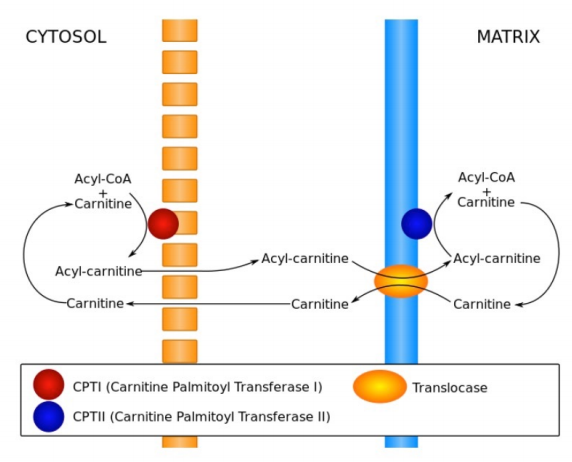24.5: Oxidation of Fatty Acids
- Page ID
- 86367
- Describe the steps of fatty acid oxidation.
- Calculate the yield of ATP from fatty acid oxidation.
Fatty acids released in the digestion of triglycerides and other lipids are broken down in a series of sequential reactions accompanied by the gradual release of usable energy.
Activation of Fatty Acids
Fatty acid oxidation is initiated in the cytosol. There the fatty acids, which like carbohydrates are relatively inert, must first be activated by conversion to an energy-rich fatty acid derivative of coenzyme A called fatty acyl-coenzyme A (CoA). The activation is catalyzed by acyl-CoA synthetase. For each molecule of fatty acid activated, one molecule of coenzyme A and one molecule of adenosine triphosphate (ATP) are used, equaling a net utilization of the two high-energy bonds in one ATP molecule (which is therefore converted to adenosine monophosphate [AMP] rather than adenosine diphosphate [ADP]):

Transport into the Mitochondrial Matrix
The fatty acyl-CoA cannot cross the membrane by diffusion and therefore must be transported into the mitochondrial matrix using a carrier molecule known as carnitine. At the outer mitochondrial membrane, fatty acyl-CoA is attached to the hydroxyl group of carnitine in a transesterification reaction catalyzed by carnitine acyltransferase I (also called carnitine palmitoyl transferase I, CPTI). The acyl-carnitine derivative is transported into the mitochondrial matrix by facilitated diffusion through a translocase protein (carnitine-acylcarnitine translocase). Once in the matrix, the acyl-carnitine is converted back to the fatty acyl-CoA and carnitine in a reaction catalyzed by carnitine acyltransferase II (also called carnitine palmitoyl transferase II, CPTI).

Oxidation of Fatty Acyl-CoA
Once inside the mitochondria the fatty acyl-CoA can enter into beta-oxidation, which is a four-step cycle that removes carbons from the fatty acid two at a time to form acetyl-CoA (which eventually yields energy in the form of ATP).
STEP 1: First \(\beta\)-oxidation (dehydrogenation of an alkane)
A fatty acyl-CoA is oxidized by the enzyme, Acyl-CoA dehydrogenase, to yield a trans double bond between the \(\alpha\)- and \(\beta\)- carbons (the first and second carbons attached to the carbonyl group). The coenzyme FAD is reduced by accepting two hydrogen atoms and their electrons forming FADH2, which moves into the electron transport chain.
The trans alkene is then hydrated with the help of Enoyl-CoA hydratase. The hydroxyl group is placed on the \(\beta\)-carbon.
The alcohol of the hydroxyacly-CoA is then oxidized to a carbonyl with the help of \(\beta\)-hydroxyacyl-CoA dehydrogenase and the coenzyme by NAD+.
The enzyme thiolase (acyl-CoA acetyltransferase) cleaves off the acetyl-CoA and attaches a new coenzyme A to the chain to yield an acyl-CoA that is two carbons shorter than before. The acyl-CoA will continue through the cycle and start back at step 1. The cleaved acetyl-CoA can then enter into the the citric acid cycle and electron transport chain because it is already within the mitochondria.
Additional steps are required for unsaturated fatty acids and those with an even number of carbons. The amount of energy released by a fatty acid is determined by the amount of ATP produced from the acetyl-CoA entering the citric acid cycle and from the reduced coenzymes NADH and FADH2 entering the electron transport chain.
ATP Yield from Fatty Acid Oxidation
The amount of ATP obtained from fatty acid oxidation depends on the size of the fatty acid being oxidized. For our purposes here. we’ll study palmitic acid, a saturated fatty acid with 16 carbon atoms, as a typical fatty acid in the human diet. Calculating its energy yield provides a model for determining the ATP yield of all other fatty acids.
The breakdown of 1 mol of palmitic acid requires 1 mol of ATP (for activation) and forms 8 mol of acetyl-CoA. Recall from that each mole of acetyl-CoA metabolized by the citric acid cycle yields 10 mol of ATP. The complete degradation of 1 mol of palmitic acid requires the \(\beta\)-oxidation reactions to be repeated seven times. Thus, 7 mol of NADH and 7 mol of FADH2 are produced. Reoxidation of these coenzymes through respiration yields 2.5–3 and 1.5–2 mol of ATP, respectively. The energy calculations can be summarized as follows:
| 1 mol of ATP is split to AMP and 2Pi | −2 ATP |
| 8 mol of acetyl-CoA formed (8 × 12) | 96 ATP |
| 7 mol of FADH2 formed (7 × 2) | 14 ATP |
| 7 mol of NADH formed (7 × 3) | 21 ATP |
| Total | 129 ATP |
The number of times β-oxidation is repeated for a fatty acid containing n carbon atoms is n/2 – 1 because the final turn yields two acetyl-CoA molecules.
The combustion of 1 mol of palmitic acid releases a considerable amount of energy:
\[C_{16}H_{32}O_2 + 23O_2 → 16CO_2 + 16H_2O + 2,340\; kcal \nonumber \]
The percentage of this energy that is conserved by the cell in the form of ATP is as follows:
\[\mathrm{\dfrac{energy\: conserved}{total\: energy\: available}\times100=\dfrac{(129\: ATP)(7.4\: kcal/ATP)}{2,340\: kcal}\times100=41\%} \nonumber \]
The efficiency of fatty acid metabolism is comparable to that of carbohydrate metabolism, which we calculated to be 42%.
The oxidation of fatty acids produces large quantities of water. This water, which sustains migratory birds and animals (such as the camel) for long periods of time.

